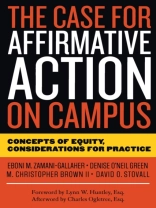* Marshalls the arguments for affirmative action* Offers strategies for action Why is affirmative action under attack? What were the policy’s original purposes, and have they been achieved? What are the arguments being arrayed against it? And-for all stakeholders concerned about equity and diversity on campus-what’s the way forward, politically, legally, and practically?The authors explore the historical context, the philosophical and legal foundations of affirmative action, present contemporary attitudes to the issue on and off campus, and uncover the tactics and arguments of its opponents. They conclude by offering strategies to counter the erosion of affirmative action, change the basis of the discourse, and coordinate institutional support to foster inclusive college environments and multi-ethnic campus communities.This book analyzes the ideological and legal construction of colorblind legislation that has led to the de facto exclusion of people of color from institutions of higher education. It addresses the role of the courts in affecting affirmative action in higher education as a workplace and place of study. It documents the under-representation of collegians of color and presents research on student opinion on race-based policies at two- and four-year institutions. It details the pervasiveness of the affirmative action debate across educational sectors and the status of race among myriad factors considered in college admissions. Finally, it considers affirmative action as a pipeline issue and in the light of educational policy.
Denise O’Neil Green & M. Christopher Brown II
Case for Affirmative Action on Campus [PDF ebook]
Concepts of Equity, Considerations for Practice
Case for Affirmative Action on Campus [PDF ebook]
Concepts of Equity, Considerations for Practice
Dieses Ebook kaufen – und ein weitere GRATIS erhalten!
Sprache Englisch ● Format PDF ● Seiten 348 ● ISBN 9781000976519 ● Verlag Taylor and Francis ● Erscheinungsjahr 2023 ● herunterladbar 3 mal ● Währung EUR ● ID 9073647 ● Kopierschutz Adobe DRM
erfordert DRM-fähige Lesetechnologie












